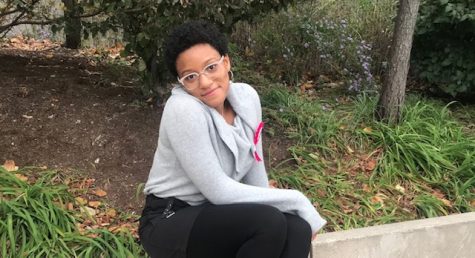Inside the library, African American students sit, chatting amongst each other. Soon, they are told by the student officers of the African American Student Achievement Program (ASAP) that they will be able to express how they feel about their place at school through a writing activity called, тАЬWhat I Wish My Teachers and Students Knew.тАЭ
Before beginning the writing activity, students and sponsors participated in a restorative circle.
тАЬIn the restorative circles, we sit down with one another and express some of our feelings towards each other, towards the subject [that we are talking about] and anything like that to be able to come to an understanding,тАЭ walking counselor Melvin Bethany said.
Bethany feels that it is important for ASAP to focus specifically on empowering African American students in a predominantly white school.
тАЬWith this battle that we have in this country, dealing with racial biases and racial split, none of that ever gets solved with anger. You have to do it in a professional way as best as possible, you have to teach it,тАЭ Bethany said.
At this meeting, not only were African American students able to express themselves, but teachers also participated in the circle.┬а
тАЬYou would think that maybe my role would be filled with a person of color, and I understand where that comes from. My background may not match with a lot of other students. I am just there hopefully to be supportive and to learn a lot,тАЭ science teacher Paul Hage said.┬а
Through the writing activity, ASAP students shared with others what it is like to be black at a predominantly white school and how that affects them in academics, sports and outside of school.┬а
тАЬI want [my teachers] to know that I am very independent, and I like to do stuff on my own. I like doing my work alone because I can listen to music, and I can focus better. It helps me do better,тАЭ sophomore Justin Willis said.
The goal of the тАЬWhat I Wish My Teachers and Students knewтАЭ activity was to leave a positive impact on the ASAP students participating while also educating teachers who are reading the messages on ways they can make a change.
тАЬI want [teachers] to be able to remove themselves and put themselves in [ASAP students] shoes. I really want [teachers] to be open-minded, to take heed to what [ASAP students] are truly trying to say,тАЭ Bethany said.┬а
ASAP students were not able to finish the тАЬWhat I Wish My Teachers and Students knewтАЭ activity because of time constraints so it became an outside activity for students to finish on their own.
тАЬWe plan on getting these out to teachers before winter break, we have gotten more letters after giving students more time to work on them,тАЭ Bethany said.
ASAP students, as well as sponsors, want people at school to know that the program is more than what people may see through the windows of the library.
тАЬI want everyone to know that in ASAP, we celebrate difference. WeтАЩre not trying to make it seem like there is no difference; weтАЩre trying to say that difference is not bad and that people bring a lot of gifts and talents to the table. If [teachers arenтАЩt] paying attention, theyтАЩre really going to miss out,тАЭ Special Education Teacher Lauren Perez said.



![Gazing up from the stage, junior Joseph McCurdy who played Peter Pan in the school play, Lost Girl, sits next to senior Juliana Rogers, who plays Wendy Darling, during a theater rehearsal. McCurdyтАЩs passion for theater began when he observed a West High production in middle school. тАЬI've been in the high school theater program since I was a freshman. I've always loved theater, but [what prompted me to join] was [when] I went to see [a performance here] when I was in middle school, and it was super cool,тАЭ McCurdy said.](https://pwestpathfinder.com/wp-content/uploads/2025/11/IMG_6535-1200x798.jpeg)

![Standing tall, stacked in a precise formation, the cheer team strikes a signature pose during halftime on Sept. 12 at the varsity football game. Nearly a month after this performance, the cheer team performed at the Missouri Cheerleading Coaches Association (MCCA) regional competition on Oct. 4, 2025. тАЬWe've all come [to] work together a lot more,тАЭ sophomore Elyssa Philippi said. тАЬWe're a lot closer than we were [earlier in the season] and going to state has made us closer [in] trying to work with each other, learn [new] skills and make our team better.тАЭ](https://pwestpathfinder.com/wp-content/uploads/2025/11/DSC5139-1.jpg)
![Handing out candy to excited trunk-or-treaters, President of the United Nations ChildrenтАЩs Fund club and junior Sara Ashok represents that group. Ashok was eager to participate in this event for multiple reasons. тАЬI really wanted to be a part of the event because I get to help create memories for kids and spend time with my friends, spreading the things [I'm passionate about],тАЭ Ashok said.](https://pwestpathfinder.com/wp-content/uploads/2025/11/DSC_8648-1-1200x800.jpg)

![Smiling in a sea of Longhorns, Fox 2 reporter Ty Hawkins joins junior Darren Young during the morning Oct. 3 pep rally. The last time West was featured in this segment was 2011. тАЬ[I hope people see this and think] if you come to [Parkway] West, you will have the time of your life because there are so many fun activities to do that make it feel like you belong here. I was surprised so many people attended, but it was a lot of fun,тАЭ Young said.](https://pwestpathfinder.com/wp-content/uploads/2025/10/Edited2-1200x798.jpg)
![West High seniors and families listen as a representative of The Scholarship Foundation of St. Louis, Teresa Steinkamp, leads a Free Application for Federal Student Aid (FAFSA) workshop. This session, held in the library, provided guidance on financial aid, scholarships and student loan options. тАЬThis event is very beneficial for any seniors who are applying to or considering applying to colleges after high school [because] the cost of college is on the rise for seniors and parents,тАЭ college and career counselor Chris Lorenz said.](https://pwestpathfinder.com/wp-content/uploads/2025/09/DSC_4478-1200x778.jpg)
![Senior Kamori Berry walks across the field during halftime at the Homecoming football game on Sept. 12. During the pep assembly earlier that day, she was pronounced Homecoming Queen. тАЬI thought it was nice that the crowd [started] cheering right away. I know [my friends] were really excited for me, and my family was happy because typically non-white people don't win,тАЭ Berry said.](https://pwestpathfinder.com/wp-content/uploads/2025/09/DSC7046-Enhanced-NR-1200x798.jpg)



Dr. Charlotte V. Ijei, L.P.C. • Jan 16, 2020 at 9:51 am
I am in awe of these students who have shared their true feelings to the administrators and counselors at Parkway West High School. Thanks to all of you who were instrumental in making this happen. Ms. Klevins, thank you for always allowing students to use their platform to report on what is of concern to them. Your guidance is appreciated.
This article touched my heart in so many ways. The ASAP program allows African-American students the chance to challenge themselves both academically and personally. Thanks to those who facilitate this initiative. These students are to be applauded for allowing others to experience what they are faced with as African-American students in a predominantly white school. To all of you, UBUNTU.